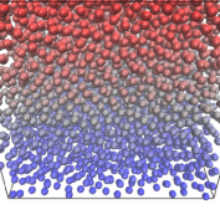Crystallization in a sheared colloidal suspension
By increasing the density, the equilibrium configuration of a charge-stabilized colloidal suspension turns from liquid to crystalline at some point. The corresponding freezing process is typically a first-order phase transition proceeding via a nucleation and growth scenario. Avoiding nucleation, e. g., by increasing the density very quickly, the suspension can be prepared in a metastable liquid state with a density beyond the thermodynamic freezing density. In this project, we study the subsequent crystallization process under the influence of simple shear flow. We find that the effect of the shearing on crystallization is two-fold: while it suppresses the initial nucleation, once a large enough critical nucleus has formed its growth is enhanced by the shear flow. Combining both effects implies an optimal strain rate at which the overall crystallization rate has a maximum. This maximum results from two shear-dependent effects affecting the crystallization at different stages. At the nucleation stage, shear flow inhibits the formation of crystalline nuclei by disrupting prestructuring in the liquid. At the growth stage the shearing strongly facilitates the crystallization growth. Tentatively, this acceleration can be related to convection.
Dynamics of fluid vesicles and micro-capsules in linear flow
Fluid vesicles such as liposomes and micro-capsules like red blood cells are ubiquitous in the human body. Their response to an applied external flow determines for example the rheology of the cardiovascular circulation and is thus of great physical and biological relevance. We investigate theoretically the dynamics of single vesicles and capsules in linear flow by using analytical models with a restricted number of degrees of freedom. In particular, we focus on the effect of thermal fluctuations on the different dynamical regimes and the transitions between these. Our aim is to construct then corresponding phase diagrams that include thermal noise.
Related publications
- Noisy nonlinear dynamics of vesicles in flow, D. Abreu and U. Seifert, Phys. Rev. Lett. 110, 238103 (2013), Abstract, Download
- Effect of thermal noise on vesicles and capsules in shear flow, D. Abreu and U. Seifert, Phys. Rev. E 86, 010902 (2012), Abstract, Download
- Micro-capsules in shear flow, R. Finken, S. Kessler, and U. Seifert, J. Phys. Cond. Mat. 23, 184113 (2011), Abstract, Download
- Elastic capsules in shear flow: Analytical solutions for constant and time-dependent shear rates, S. Kessler, R. Finken, and U. Seifert, Eur. Phys. J. E 29, 399-413 (2009), Abstract, Download
- Swinging and tumbling of elastic capsules in shear flow, S. Kessler, R. Finken, and U. Seifert, J. Fluid Mech. 605, 207-226 (2008), Abstract, Download
Tagged particle in a sheared colloidal suspension
The mobility of a colloidal particle immersed in a solvent determines the velocity of the particle in response to an applied external force. In thermal equilibrium, the Einstein relation expresses the deep connection between this linear response coefficient and the diffusivity of this particle. However, driving the system beyond the linear response regime around equilibrium this relation does not apply. By means of extensive Langevin dynamics simulations, we aim to understand the nonequilibrium behaviour of colloidal suspensions by analyzing characteristic quantities such as mobility and diffusion constants. Furthermore, we investigate under which circumstances and to what extent the definition of an effective nonequilibrium temperature as a fluctuation-dissipation ratio is a good approximation.
Related publications
- Effective confinement as origin of the equivalence of kinetic temperature and fluctuation-dissipation ratio in dense shear driven suspension, B. Lander, U. Seifert, and T. Speck, Phys. Rev. E 85, 021103 (2012), Abstract, Download
- Mobility and diffusion of a tagged particle in a driven colloidal suspension, B. Lander, U. Seifert, and T. Speck, EPL 92, 58001 (2010), Abstract, Download





